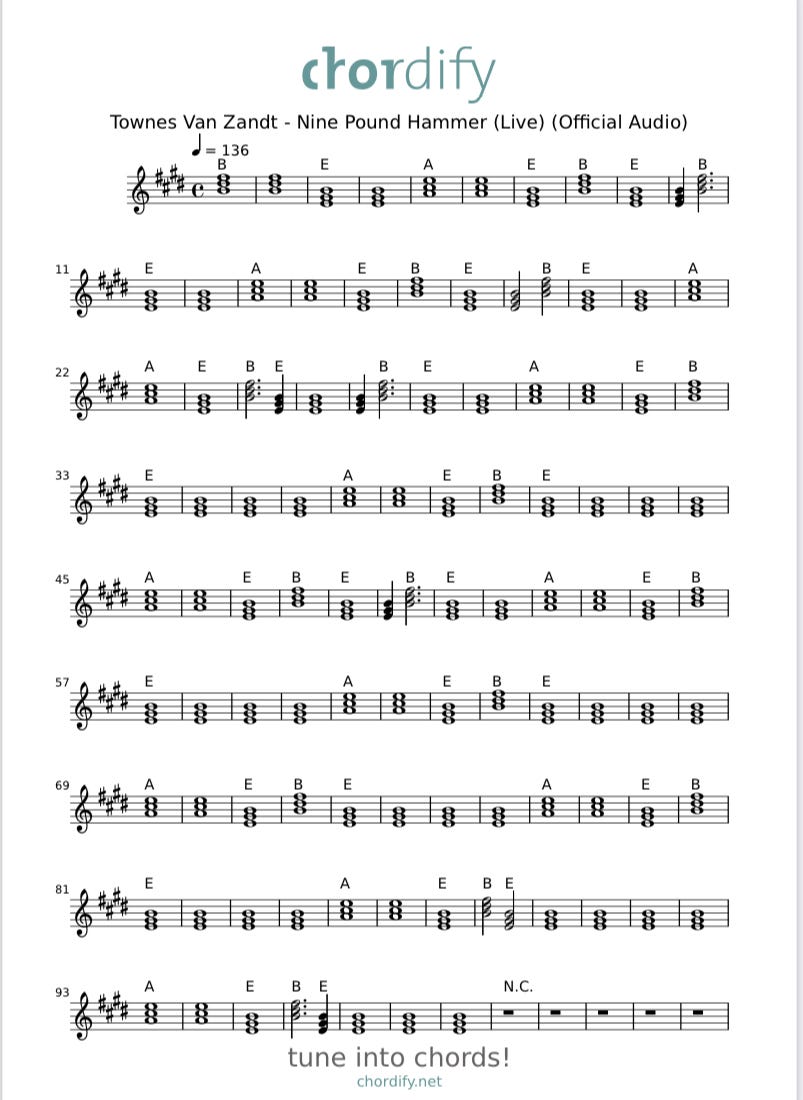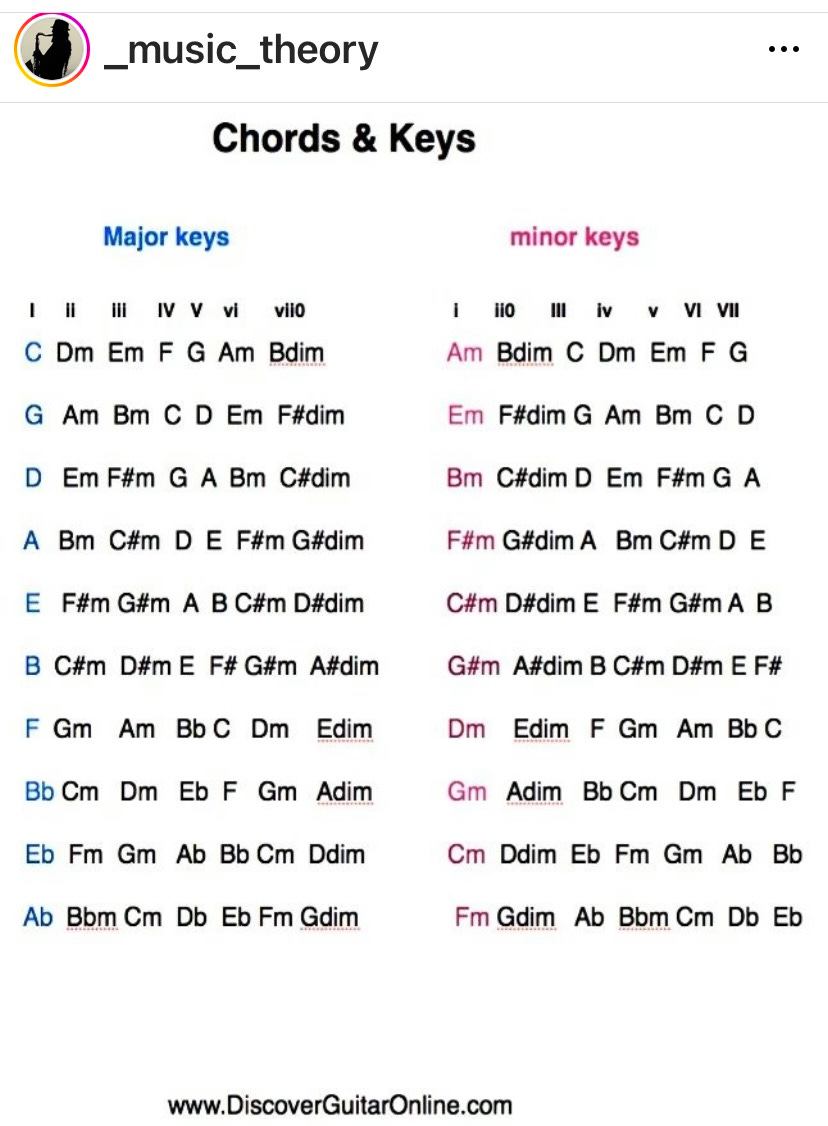Last Week’s Bonus Round:
“Nine Pound Hammer” or “9 LB. Hammer” is a traditional Appalachian folk song from Muhlenberg County, Kentucky. It dates back to the 1870’s and verses were adapted into the 20th C. The song was popularized after World War II by country and western singer Merle Travis in his 1947 box set of 78 RPM recording Folk Songs of The Hills. Along with the traditional folk songs, Travis wrote several other working songs including “Sixteen Tons” and “John Henry”. “Nine Pound Hammer” was one of a group of “hammer songs” or “roll songs” (after a group of wheelbarrow-hauling songs).”
Credit: vancouversignaturesounds.com Link: Nine Pound Hammer
(Ed. See yesterday’s “Thursday Links” posts for a link to an article about “traditional” (public domain) songs and how copyright laws apply, or don’t. Link: Thursday Links )
This version (and there are many!) is in the Key of EMajor, 4/4 time, a pretty quick 136 BPM.
(Ed. - I don’t always trust Chordify’s algorithm to accurately analyze tempo when the accompaniment is a flat- or finger- picked guitar, it seems to me it’s harder (and understandably so) for the algorithm to pick up the “beat” with guitar songs that aren’t strummed and don’t have a percussion track. I kinda think this was a bit slower than 136 BPM, and I would definitely play it a bit slower - your mileage may vary…).
The 3 chords are the I, IV and V chords of the Key of EMaj. Capo on 2 to change the EMaj, AMaj and BMaj to stay in the original key but use the to DMaj, GMaj and AMaj chords. Or leave the capo off and just play/sing it in DMaj.
Disclaimer: This Substack is free, always will be, and I receive no compensation or other benefit (except the unsolicited, occasional, and much appreciated shoutout from readers and other Substackers!) from any of the people or companies or products I link to or write about. Note some images and other material may be copyrighted by the original author or composer and appear here under the “Fair Use” doctrine. Link: Fair Use
Michael Acoustic
Thanks new subscribers! Mika, the Cat, welcomes you!!
This Week’s Conversation With Mika:
Mika: “I want to go back outside!”
Me: “So you can jump up on the deck railing and stalk the little quail family again?”
Mika: “LALALALALALALA - I can’t hear youuuuuu…………..they were mocking me….stop looking at me….”
Me: “sigh…”
Last week we talked about the intro and the first verse to the song “Long Road Back”. I didn’t reference the intro much, but the capoed chord progression (*see more on this below) is “G Am D C G” - the verses don’t include the CMaj chord, but the chorus does. My personal opinion (only) is that the purpose of the intro is to set the stage for the song, in tempo, rhythm, style, timing, etc - but not much else. IMHO, the intro serves as a “teaser” of sorts. I think intros should be somewhere between 10 - 30 seconds - any more and for me the song starts to become about the intro and not the song itself. So I ‘teased” most of the chord progression for the song in the intro. I say “most” because the progression for the bridge is different - I didn’t want to give away that difference in the intro, so the bridge could serve its purpose. We’ll get to that in a minute.
Back to the writing process:
*(Again, note these are the chord “shapes” I’m playing, but since I’m playing capoed on the second fret, they’re not the actual musical chords, which are in the Key of AMaj: AMaj, Bm, DMaj, EMaj or the I, ii-, IV and V, transposed by the effect of the capo to GMaj “shapes” ).
Maybe this will help if that’s confusing, note the I, ii-, IV, and V of both GMaj and A Maj:
So - kind of a disclaimer - we saw this paragraph last week and I’m including it again here: “I’m always going on about putting in identifiers for your music. I practice what I preach - this information (as applicable to each particular song) is on every chord chart, lyric sheet, whatever I produce, and I make sure it’s accurate.
Note: the Sound Recording Copyright, ISRC and UPC were added after I got the registration from the copyright office and then the codes from CD Baby upon release.”
LONG ROAD BACK 4/4 75 BPM KEY OF AMaj NOTE: *CAPO On 2
WRITER/COMPOSER MICHAEL CLAYTON HIRST ASCAP IPI 1027367371 PUBLISHER 10 SONGS MUSIC LLC ASCAP IPI 1027367273
ASCAP WORK REGISTRATION 908377871 DATE 06/29/2020
US COPYRIGHT COMPOSER/PUBLISHER # 1-9200074421 DATE 09/02/2020
US COPYRIGHT (SOUND RECORDING)# SR 956-659 DATE 05/30/23
ISWC T9330602238 ISRC: ushm82304479 UPC: 198025373053
LONG ROAD BACK
…
CHORUS
D
MAYBE ONE DAY (CRESCENDO)
EM
DOWN THAT WINDING TRACK
C (DIMINUENDO)
END THIS CRUSHING QUIET
D (MF) G
BUT IT’S A LONG ROAD BACK
BRIDGE
AM7
DOESN’T SEEM SO LONG AGO
D7
WASN’T THE LOVE WE LACKED
GMAJ7
OUR SILENCE LONGS TO END NOW
C D G
OH, BUT IT’S A LONG ROAD BACK
© Copyright 2020, 10 Songs Music, LLC, All Rights Reserved
The chorus has “dynamics” notations in parentheses - these were reminders to myself how I wanted the dynamics of the chorus to sort of reflect the “feel” of the chorus - a build up of volume (“Crescendo”) in the first two lines to contrast the line “End this crushing quiet” (“Diminuendo” - meaning “quieter”), before the final line (MF stands for “mezzo-forte” - meaning “moderately loud”) increased in volume. The point was to emphasize “by reduction” the 3rd line - which was sort of the “hopeful” part of the chorus - not by increasing the volume of that line, but of the surrounding lines, so the line with the word “quiet” was actually noticeably quieter in contrast. Whether I wholly succeeded is debatable, but that was my intent anyway.
Next, the bridge. What’s a “bridge”? Here’s the “book definition”:
“In music, especially Western popular music, a bridge is a contrasting section that prepares for the return of the original material section.”
Credit: Wikipedia Link: The Bridge
Note that the bridge is sometimes referred to as the “middle 8”, which is sort of the British way of referring to this section in a song, but is distinct in that it refers to an 8 bar portion among other 8 bar sections (verse, chorus) - so somewhat more rigid in definition.
The bridge in “Long Road Back” is probably 8 bars (measures) because the last line has a chord change at the end of the measure containing the words “|Oh, (which is held), but it’s a long road | back (then instrumental for the last 3 beats)|”. It contains all of the chords that are present in the intro, but three of them are extended chords.
The extended chords in the bridge of “Long Road Back” are Am7, D7, and GMaj7 and in that order they are kind of “special” in music. That progression is called a ii-, V, I (or 2,5,1) progression - often heard in jazz music. It can be either the triads (in our example that would be Am, DMaj, GMaj) or more often as extended 7 chords, played as a ii-7, V7, IMaj7. The “flavor” of the chords is specific, the ii is a minor 7, the V is played as a Dominant 7 and the I as a Major 7.
(Note: “In music theory, a dominant seventh chord, or major minor seventh chord,[a] is a seventh chord, usually built on the fifth degree of the major scale, and composed of a root, major third, perfect fifth, and minor seventh. Thus it is a major triad together with a minor seventh, denoted by the letter name of the chord root and a superscript "7".[3] ) Credit: Wikipedia - Dominant 7 Chords
So. The ii-, V, I played as sevenths (when spoken musicians usually just say “seven chord” or the “seven” to distinguish it as a “seven” chord in a key as opposed to the seventh note in a scale) is the tool I used to change the bridge a bit and give it a distinguishing sound before returning to the IV - V - I “triad” chord progression that finishes out the bridge.
We’ll talk more about lyric choices and the process of arriving at a more or less “final” version in next week’s concluding part to this series.
“It’s never really final - you just run out of things you can bear to change…”
- Michael Acoustic, being all erudite and self referentialish…..
Did that hurt a bit? I was reaching waaay back to music theory classes for a lot of that and checking references the whole way! I get it if you want to gloss over the theory. It can be difficult. The point though, is if you’re writing songs, or thinking of writing songs - finding a way to distinguish sections that catch the listener’s ear (even, or maybe especially, if they don’t know why it does) is important. That usually involves applying more than a little “theory”….
Shameless self promotion section -
See if you can pick out the parts we talked about last week and today….
What I’m Listening2: (I keep a list of the ones I’ve already shared and this one wasn’t on it, but dunno, maybe I already did. Good stuff, in any event…)
Bonus Round: Double Feature?
Cheers and keep playing!!
Michael Acoustic






There's my bridge!🌉What a coincidence I ask you about it hours before I read about it (I'm so behind)! Great playlist---loved the last two: Emmylou and Rosanne! Ever listened to Carlene Carter, daughter of June Carter Cash and Carl Smith (Johnny's her stepdad)? I always really liked her (so pretty, too)! She first recorded in '78, and was on Warner Bros.